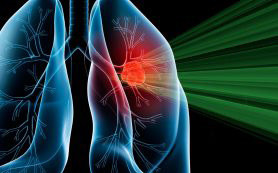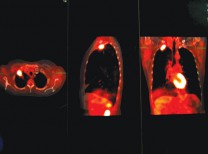Last October, Desert Regional introduced TrueBeam, the latest technology for radiation therapy which aims to reduce treatment time and the effect on surrounding tissues.
We spoke with Comprehensive Cancer Center Radiation Oncologist, Dr. Amir Lavaf, to learn more and see how this new technology is changing the way they treat cancer.
Dessert Health: Is TrueBeam truly the latest-and-greatest and how long will it continue to be so?
Amir Lavaf: Yes, it is. We expect TrueBeam to be the leading architecture for the next ten years. New developments to enhance the technology will be primarily in software.
DH: What is its primary purpose and what type of cancers does it treat?
AL: It is a general purpose machine for a variety of cancers. Its greatest benefits include the increased dose rate, which is up to four times more than any other machine, so treatments will be four times faster than previous technology, and more precise as its accuracy is down to .1 millimeter, or the size of a pinhead. We are also able to view tumors with more precision as its CT scan imaging has been enhanced to diagnostic quality. It is also equipped with a 6-axis table, which allows us more ways to target and destroy the tumors, while sparing the healthy tissue around it.
So with the imaging, accuracy and dose rate, the technology works for multiple types of treatments and cancers, but comes in most handy in radio-surgery. We are ablating tumors all over the body – in the brain and in the lung – without ever cutting the patient, and it is completely painless.
DH: What is the difference between proton therapy and this new technology which uses photons?
AL: Proton therapy, which has been around for 30 years or so, uses particle matter whereas TrueBeam uses photons, or light beams of energy. While proton therapy is very effective in certain applications, especially with childhood cancers, it has shortcomings for general purpose use including the tendency for particles to scatter at different types of interfaces, particularly in tissue-air interfaces. Our technology has the ability to target down to the size of a pinhead without affecting surrounding tissue.
DH: Does this therapy leave marks on the skin as traditional radiation may?
AL: TrueBeam can still deliver traditional forms of radiation that affect the skin in terms of redness and tanning, but we are using new techniques that have reduced this significantly. Breast cancer patients who are treated with this new technology are experiencing a lot less skin toxicity than with other technology, and that is due largely in part to the amount of modulation we are able to apply to the radiotherapy. Prostate cancer patients will have no effects on the skin.
DH: What are the greatest results you have seen?
AL: Results have been fantastic, especially with radio-surgery as this precise targeting allows us to radiate less tissue and to spare more normal tissue. We are finding it very effective in ablating lung cancer or metastatic disease from the lung, brain and liver. With breast and prostate cancer, it has increased our ability to treat faster and to treat more accurately so that patients experience fewer side effects.
For more information, contact Desert Regional Medical Center’s Comprehensive Cancer Center at (760) 416.4700 or visit www.DesertRegional.com/cancer.












































Comments (0)